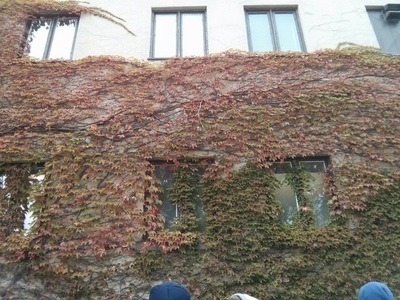Common Name: Boston ivy
Scientific Name:
Family: Vitaceae
Genus: Parthenocissus
Species: tricuspidata
Hardiness Zone: 4 to 8
Height: 30 to 50 ft
Width: 5 to 10 ft
Common Characteristics:
Boston Ivy is a Chinese native that is a rapid-growing, deciduous, woody vine. It is a self-supporting tendril climber that can quickly expand across flat surfaces such as stone or brick. Boston Ivy is able to stick to walls because of adhesive holdfasts, also known as sucker disks, that are located at the tendril ends. The leaves are glossy dark green and are simple with serrated margins and have three lobes. In late spring to early summer, greenish-white flowers bloom but they are hidden by the green foliage so they are ornamentally insignificant. After the flowers bloom, they give way to bluish-black berries that are about 1/3 inches in diameter. These berries are generally covered by the leaves until fall when the leaves are gone. In the fall the leaves turn red to purple. In warmer climates, foliage can be semi-evergreen.
Where it Grows:
Boston Ivy is easily grown in average, dry to medium, well-drained soils in full sun to part shade. This vine is well-suited for urban areas since it has a tolerance for a wide range of soils and urban pollution/conditions. For the best fall colors, plant in full sun. If planted in USDA Hardiness zones 8 and 9, the vine will do best on eastern and northern facing walls.
How it's Used:
It is widely planted across North America and is commonly seen as a decorative aspect of buildings. Boston Ivy is also excellent for trellises, arbors, or fences. It may also be grown on the ground to cover old tree stumps and other eyesores or for erosion control on slopes. Trimming may be necessary to keep this plant within the desired bounds but isn't normally needed for the survival of the plant.
Ecosystem Services:
The berries provide food for birds in the fall and into the winter.
Where it is Native to:
It is native to eastern Asia, Japan, Korea, and eastern China.
Known Varieties and Their Traits:
-
Fenway Park Boston ivy (Parthenocissus tricuspidata ‘Fenway Park’): This cultivar has yellow leaves in the spring that turn to chartreuse in the summer and then change to red in the fall.
Problems:
No serious insect or disease problems. Mildews, leaf spots, canker, and wilt may occur. Once attached to the side of a building or wall, this vine becomes difficult to remove and will damage painted surfaces and leave residues.
References:
